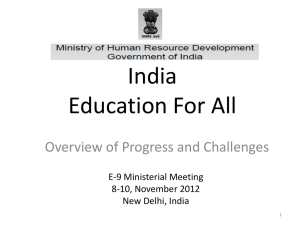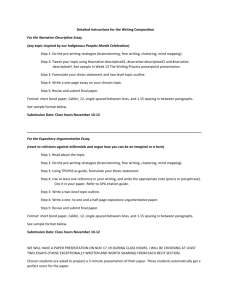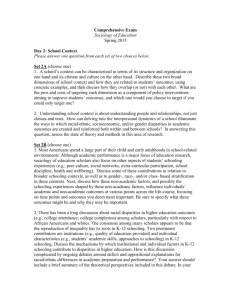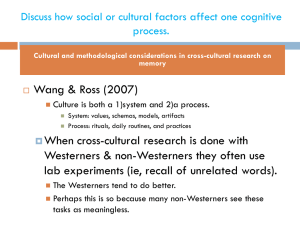The Challenges facing South Africa`s Secondary Schooling System
advertisement
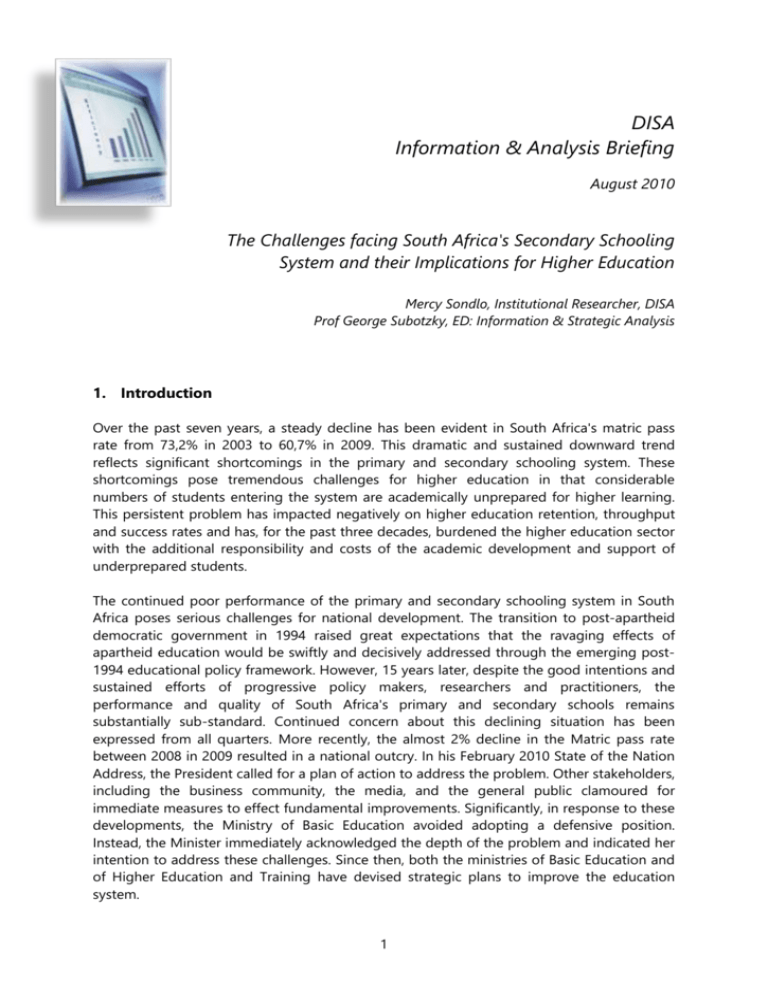
DISA Information & Analysis Briefing August 2010 The Challenges facing South Africa's Secondary Schooling System and their Implications for Higher Education Mercy Sondlo, Institutional Researcher, DISA Prof George Subotzky, ED: Information & Strategic Analysis 1. Introduction Over the past seven years, a steady decline has been evident in South Africa's matric pass rate from 73,2% in 2003 to 60,7% in 2009. This dramatic and sustained downward trend reflects significant shortcomings in the primary and secondary schooling system. These shortcomings pose tremendous challenges for higher education in that considerable numbers of students entering the system are academically unprepared for higher learning. This persistent problem has impacted negatively on higher education retention, throughput and success rates and has, for the past three decades, burdened the higher education sector with the additional responsibility and costs of the academic development and support of underprepared students. The continued poor performance of the primary and secondary schooling system in South Africa poses serious challenges for national development. The transition to post-apartheid democratic government in 1994 raised great expectations that the ravaging effects of apartheid education would be swiftly and decisively addressed through the emerging post1994 educational policy framework. However, 15 years later, despite the good intentions and sustained efforts of progressive policy makers, researchers and practitioners, the performance and quality of South Africa's primary and secondary schools remains substantially sub-standard. Continued concern about this declining situation has been expressed from all quarters. More recently, the almost 2% decline in the Matric pass rate between 2008 in 2009 resulted in a national outcry. In his February 2010 State of the Nation Address, the President called for a plan of action to address the problem. Other stakeholders, including the business community, the media, and the general public clamoured for immediate measures to effect fundamental improvements. Significantly, in response to these developments, the Ministry of Basic Education avoided adopting a defensive position. Instead, the Minister immediately acknowledged the depth of the problem and indicated her intention to address these challenges. Since then, both the ministries of Basic Education and of Higher Education and Training have devised strategic plans to improve the education system. 1 This briefing presents an overview of the challenges being faced by the basic education sector. It highlights the key issues in secondary schooling in the light of how these may impact on higher education. Lastly, it summarizes both departments’ long-term and medium-term strategic plans for improving the standard of education as a way forward. 2. Overview of the Challenges Facing the Schooling System As indicated, the clearest indication of the underperformance of South Africa's schooling system is its declining overall Matric pass rates and, in particular, poor results in the critical subjects of Mathematics and Physical Science. Figure 1: National Pass Rates Senior Secondary Certificate (1998-2007) and National Senior Certificate (2008-9) 80% 70% 60% 50% 40% 30% 20% 10% 0% 1998 1999 2000 2001 2002 2003 2004 2005 2006 2007 2008 2009 Pass Rate 49,3% 48,9% 57,8% 61,7% 68,9% 73,2% 70,7% 68,3% 66,5% 65,2% 62,5% 60,6% Figure 1 above shows that the overall national Matric pass rate peaked at 73,2% in 2003 and then steadily declined to 60,6% in 2009. Of particular concern is that after 2007 (the last year of the Senior Certificate), the decline was particularly sharp from 65,2% to 62,5% in 2008 and from there to 60,6% in 2009 (the first years in which the National Senior Certificate was written). Figure 2: NSC Results by Type, 2008-9 600 000 500 000 400 000 300 000 200 000 100 000 0 2008 2009 WROTE FAILED NSC HC DIPLOMA BACHELORS TOTAL 533 561 100,0% 199 817 180 102 032 124 258 107 274 333 744 37,4% 0,05% 30,6% 37,2% 32,1% 62,6% 552 073 217 355 630 93 356 131 035 109 697 334 718 100,0% 39,4% 0,19% 27,9% 39,1% 32,8% 60,6% From Figure 2 can be seen that of the 552 073 NSC candidates in 2009, 217 355 or 39,4% failed. Although the number of candidates increased between 2009 and 2008, the lower pass rate of 60,6% in 2009 meant that the total number of passes increased only 2 minimally from 333 744 in 2008 to 334 718 in 2009. The total pool of higher education entrants therefore remained static. Further, this pool of entrants is divided among those achieving access to the various qualification levels in higher education. Of those that passed in 2009, 93 356 (27,9%) achieved access to the higher certificate, a further 131 035 (39,1%) achieved access to a diploma and 109 697 (32,8%) to a bachelor qualification. No figures for the race groups were provided by the Department of Basic Education. However, proportionately, female learners clearly outperformed their male counterparts in all these categories. Figure 3: NSC Mathematics Pass Rates, 2008-9 Figure 2 indicates that around 54% of NSC candidates in Mathematics in 2008 and 2009 failed to achieve a 30% mark, with only around 30% achieving marks above 40%. Figure 4: NSC Physical Science Pass Rates, 2008-9 Figure 3 illustrates a sharp increase in the percentage of failures to achieve a 30% mark in Physical Science from 45,07% in 2008 to 63,17% in 2009. Correspondingly, the percentage of candidates achieving marks of 40% and above declined from 28,66% in 2008 to just 20,58% in 2009. 3 Figure 5: NSC Accounting Pass Rates, 2008-9 Figure 5 shows that around 38% of NSC Accounting candidates in 2008 and 2009 failed to achieve a 30% mark. While around 61% achieved a mark of 30% and above, only 31,3% achieved a mark of 40% and above in 2008. Slightly encouraging was the increase to 36% in 2009. Figure 6: Endorsement/Bachelor Passes Senior Secondary Certificate (2004-7) and National Senior Certificate (2008-9) Figure 6 shows a decline from 17,0% in 2005 to 15,1% in 2007 in the percentage of endorsements under the Senior Certificate. The sharp increase was evident to 20,1% in 2008 in the percentage of NSC candidates obtaining entrance to bachelor degrees. While moving in the right direction and increasing the pool of university entrants, this sudden upward trend raised concerns about the standards of the new NSC and its reliability in assessing readiness for higher learning. Many institutions experienced higher than normal failure rates in first-time entering students in 2009 – at trend which corroborates these concerns. Despite the substantial increase between 2007 and 2008, a slight but nonetheless worrying decline was evident to 19,9% in 2009. 4 Figure 7: NSC Pass Rates by Province, 2008-9 90% 80% 70% 60% 50% 40% 30% 20% 10% 0% Eastern Cape Free State Gauteng KwaZulu-Natal Limpopo Mpumalanga North West 2008 50,6% 71,8% 76,4% 57,6% 54,3% 51,8% 68,0% Northern Cape Western Cape 72,7% 78,4% National 62,6% 2009 51,0% 69,4% 71,8% 61,1% 48,9% 47,9% 67,5% 61,3% 75,7% 60,6% Figure 7 shows the wide variation in the NSC pass rates among the provinces. In 2009, this ranged from a high of 75,7% in the Western Cape, followed by 71,8% in Gauteng to a low of 45,9% in Mpumalanga, followed by 51,0% in the Eastern Cape. Except for KwaZulu-Natal, which experienced an increase from 57,6% to 61,1% and the Eastern Cape, which increased marginally from 50,0% to 51,0%, a decline was evident in the pass rates of all other provinces between 2008 and 2009. This shows that even the higher performing provinces could not improve performance in 2009. These results reflect an unacceptably high overall failure rate, with well over 200 000 NSC candidates in 2009 failing to achieve even the lowest school-leaving qualification. In particular, the poor and declining results in the key subject areas of Mathematics and Physical Science bodes very badly for South Africa's aspirations towards national development, innovation and effective engagement in the global knowledge society. Besides the NSC, another indicator of poor performance in South Africa's schooling system is the National Benchmark Tests, which were developed to assess levels of school leavers' academic and quantitative literacy. As can be seen from Figure 8 below, in 2009, less than half of those tested showed proficiency in academic literacy and only a quarter showed proficiency in quantitative literacy. This indicates clearly the severity of underpreparedness among the majority of learners entering the higher education system. 5 Figure 8: National Academic & Literary Benchmark Tests, 2009 7 000 6 000 5 000 4 000 3 000 2 000 1 000 0 Academic Literacy Quantitative Literacy Proficient Intermediate Basic 5 780 5 571 851 47% 46% 7% 3 022 6 125 3 055 25% 50% 25% In the academic literacy test, only 47% achieved proficient levels, 46% achieved intermediate levels and 7% basic. In the quantitative literacy test, only 25% achieved proficient levels, 50% achieved intermediate levels and 25% basic. This sustained poor performance reflects the severity of the challenges facing the basic schooling system. As mentioned, the Minister openly acknowledged the crisis in the schooling system and the need to raise awareness of this. In her press statement following the release of the 2009 Matric results, the Minister made the following observations: The 60,6% pass rate is disappointing. The NSC is an important indicator of our national education system and as a country we cannot afford to allow our young people to achieve results that are in the main average or below average. Mathematics, Physical Science and Accounting need urgent attention. Factors contributing to the failure of the system include the socio-cultural environment within and outside the school. Within the system, the root causes of the above problems can be attributed to poor teaching, weak management, lack of leadership and commitment. At its briefing to the Parliamentary Portfolio Committee on 4 May 2010, the Department of Basic Education (DBE) identified the following critical areas needing urgent attention: 1. Poor standards of literacy and numeracy. 2. Underperformance of learners in Physical Science. 3. Supply of new teachers, recruitment of qualified teachers and challenges of the distribution of teachers in their areas of expertise. 4. Lack of adequate resources in schools such as classrooms, computers, text books and laboratories. 5. The delays and limited funds available in addressing infrastructural backlogs in the long-term. 6. The lack of access to basic services such as water, electricity and sanitation. 7. Lack of adequate support systems and structures especially for learners from low socio-economic backgrounds. 6 Likewise, in a briefing presented to the Parliamentary Portfolio Committee on 3 February 2010, Umalusi commented on the poor performance of learners in the Mathematics, Physical Science and Accounting subjects and emphasised the need for “progress regarding the curriculum transformation process”. The following priorities were identified: 1. Quality assurance processes need to be monitored moderated and standardized. 2. Professionalism and union activities must be brought into appropriate balance. 3. The perception that the level of the Physical Science examinations was pitched too high must be addressed. These clamours for immediate and effective remedial action by all stakeholders prompted a series of responses from the DBE. These are now briefly discussed. Since the role of basic education in preparing learners for higher education is acknowledged in these responses, it is important to continuously monitor progress on implementation of these interventions and to assess their likely impact on higher education. 3. The Department of Basic Education's Strategic Plan In response to these developments, the Department of Basic Education (DBE) recently released its long-term strategic plan entitled Schooling 2025: An Action Plan for the Improvement of Basic Education. This provides the clearest indication of the range of planned interventions identified to address all the challenges facing South Africa's schooling system outlined above. Below is a summary of the key issues and the proposals on the way forward by the DBE. The Action Plan focuses on two broad areas namely, improved access to education and improvement of learning outcomes. The key strategic objectives, activities and targets of the Strategic Plan 2010-13 are as follows: 1. Improved curriculum implementation. 2. A new integrated plan for teacher development to increase the pool of well qualified new teachers. 3. Workbooks for Grade R to 9 learners and teacher manuals. 4. Enhanced education management development capacity within the system. 5. Integrated strategy on the assessment of learners. 6. Establishing a long-term sector plan, Schooling 2025: An Action Plan for the Improvement of Basic Education. 7. Better reporting on the outcomes of basic education. 8. Promotion of the e-Education strategy through web-based access to education information. 9. Enhanced pro-poor packages to eradicate previous inequalities in school funding. Within these, 15 key outputs and 45 goals are identified, each with a target indicator for measuring progress. These cover the period up to 2025 and include five-year horizons with one-year sets of performance measures and targets to assess delivery. The key interventions to accelerate implementation are identified as follows: 7 1. An Annual National Assessment Strategy to monitor and track progress on laying solid foundations for learning literacy and numeracy by learners in grades 1- 6 and 9. 2. Creation of a Delivery Unit in the Department of Basic Education working in collaboration with the Delivery Unit in the Presidency, mandated to monitor the progress of implementation of the Schooling 2025 Action Plan. 3. The fast tracking of the Accelerated Infrastructural Delivery Plan. In her response to questions regarding primary and secondary schools infrastructure, posed in the National Assembly for written reply posted on 25 March 2010, the Minister of Basic Education mentioned that there was a reduction in infrastructural backlogs for libraries, computer centres and related facilities, including access to water, sanitation and electricity in all schools. The current budget for infrastructure is R5.5 billion and will continue to increase over the medium term to reach R9.4 billion in 2012/13. 4. The development of a quality learning and teaching campaign which includes the formation of Quality Learning and Teaching Campaign (QLTC) structures and community mobilization programmes. 5. The provision of effective support to schools by districts. 4. Curriculum Review In a Media Statement on the progress of the review of the National Curriculum Statement on 6 July 2010, the Minister of Basic Education indicated some decisive shifts in approach. She stated: “The new Curriculum and Assessment Policy Statements will repackage the existing curriculum into the general aims of the South African curriculum, the specific aims of each subject, clearly delineated topics to be covered per term and the required number and type of assessment, also per term”. While directly avoiding the politically embarrassing acknowledgement that outcomes-based education had failed and was being replaced, the Minister indicated the adoption of measures which, in effect, are aimed at reversing OBE. These measures include: Short-term relief to address teacher curriculum and administrative overloads. Reduction of the number of learning areas (now to be called "subjects" across the curriculum) in the intermediate phase from eight to six. Phasing in of the Curriculum and Assessment Policy Statements in the Foundation Phase in 2011 and other grades in 2012. Development and distribution of learning and teaching materials, including a plan for the development workbooks for learners in Grade 1-6. Teaching and learning language chosen by the learner will be taught as a subject or as a first additional language from Grade 1. Implementation of regular, externally-set assessments at grades 3, 6, and 9 in literacy and numeracy. 5. Implications for Higher Education and Unisa Failure to effectively implement all these measures to address the myriad of challenges facing basic education will undoubtedly prolong the negative impacts of poor performance on higher education. The persistently poor quality of entering students will obstruct the attainment of higher education goals and continue to burden the higher education sector 8 with the costs and efforts of the academic support and development of underprepared students and the associated costs of poor retention, success and graduation rates. Given its social mandate and ODL character, the impact of these persistent problems and challenges on Unisa are particularly strong. The substandard quality of outputs of the schooling system creates greater urgency to develop an effective and comprehensive success and retention strategy, student support framework and high-quality academic and administrative services. As a means to address the challenges facing the higher education sector, particularly in the light of the ongoing poor performance of South Africa's schools, the Minister of Higher Education and Training tabled the following proposals in his keynote address at the recent Higher Education Summit held on 22 April 2010: 1. 2. 3. 4. 5. 6. 7. 8. Improving success, retention and throughput rates. This is a priority, given the fact that less than half of first-year entrants actually graduate. Low success and high drop-out rates are linked to inadequate funding, inadequate infrastructure (badly stocked libraries and laboratories), poor student accommodation and living conditions, inadequate academic preparation for university studies and poor staff qualifications in historically disadvantaged universities. The appointment of a task team to review the universities' funding framework that will focus on the disadvantaged universities. The appointment of another task team, led by Prof Ihron Rensburg, to make recommendations on expanding and improving student accommodation. Expansion and improvement of NSFAS. The NSFAS Review Committee report has been released for public comment. University enrolments to expand over the next few years, including through the establishment of new universities in Mpumalanga and the Northern Cape. Further curriculum reform relevant to student needs and the expansion of student support programmes, e.g. foundation courses. Strengthening of African language departments to produce African language teachers and develop African language literature and cultivate a culture of reading among children and young people. The development of a Green Paper on the post-school education and training system for public discussion. This will analyse the current situation and set out objectives and priorities for the various sub-systems, including higher education, with the purpose of integrating education and training. After thorough public scrutiny and debate, the Green Paper will be converted into a White Paper which will guide the department's policy framework, plans and activities over the years to come. This will represent the next major point of departure for higher education policy and practice. In addition, the Department of Higher Education & Training recently released its strategic plan. The focus, substance and implications for higher education were set out in a recent DISA briefing, which was distributed via Unisa's Intcom and is available on the Institutional Information & Analysis Portal. 9 Clearly, higher education also has an important role in improving schooling. Through its teacher education responsibilities and ongoing educational research activities and outreach towards schools, educationists in the higher education sector can make a significant contribution to supporting the DBE's initiatives. In particular, renewed analysis of all the factors enhancing and obstructing school effectiveness will help to address the current shortcomings in the schooling system. 6. Conclusion In summary and conclusion: In 2009, the national Matric pass rate declined by almost 2% from 62,5% in 2008 to 60,6%. This follows a steady decline from a peak of 73,2% in 2003. Of particular concern is the poor performance in the key subject areas of Mathematics and Physical Science and declining performance since the introduction of the new National Senior Certificate in 2008. These trends indicate fundamental problems and challenges in South Africa's schooling system. They have major implications for higher education. Underprepared learners entering the system will need ongoing support and development, and will impact negatively on retention, success and graduation rates. The Department of Basic Education has formulated a long-term strategic plan, Schooling 2025: An Action Plan for the Improvement of Basic Education to address these challenges. As part of this, a range of immediate interventions have been identified. It remains to be seen how effectively these will rectify the problems deeply embedded in South Africa's schooling system. Clearly, a systematic, sustained and aggressive turnaround strategy is required to effectively address this persistent and urgent crisis. In parallel, the Department of Higher Education and Training has developed its long-term strategic plan to address the challenges facing the sector. Higher education has a crucial role to play in improving the quality of schooling through effective teacher education, schools outreach and in researching school effectiveness. The impact of the planned interventions to improve the quality of schooling will only be able to be measured over time. In the interim, South Africa's higher education sector will have to continue to carry the burden of the support and development of underprepared learners. Sources 1. 2. 3. 4. 5. Minister of Basic Education press release, 7 January 2010. Department of Basic Education presentation to the Parliamentary Portfolio Committee, 3 February 2010. Umalusi presentation to the Parliamentary Portfolio Committee, 3 February 2010. Minister of Higher Education & Training keynote address, Higher Education Summit, 22 April 2010. Department of Basic Education briefing report: Schooling 2025: An Action Plan for improving Basic Education presented to the Parliamentary Portfolio Committee, 4 May 2010. 6. Minister of Higher Education & Training media statement on the National Curriculum Statement, 6 July 2010. 10


